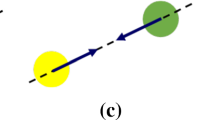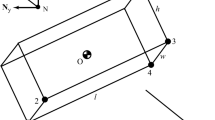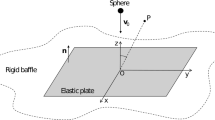Abstract
In this paper, a simplified numerical approach for finite element dynamic analysis of an inelastic solid structure subjected to solid object impact is presented. The approach approximates the impacting solid as the selected multiple nodes, for which mass of the impactor is distributed. The node-to-segment contact formulation with the penalty constraint technique incorporated is employed to impose contact conditions between the nodes and the surface of the receiver structure. The node-to-segment algorithm is integrated into Newton–Raphson time integration scheme and the Lagrange multiplier technique is applied to enforce the identical displacements for the selected nodes throughout the analysis process. The approach is verified using two-dimensional plane strain models considering elastic-perfectly-plastic material behavior. The results obtained using the proposed approach are in a good agreement with those simulated using a commercial finite element code, ABAQUS dynamic/implicit, in terms of displacements and stress distribution fields. The proposed approach is shown to be computationally superior to general finite element method-based contact/impact analysis without significantly sacrificing the accuracy.

















Similar content being viewed by others
References
Alves, J., Peixinho, N., da Silva, M.T., et al.: A comparative study of the viscoelastic constitutive models for frictionless contact interfaces in solids. Mech. Mach. Theory 85, 172–188 (2015). https://doi.org/10.1016/j.mechmachtheory.2014.11.020
Asano, N.: A virtual work principle using penalty function method for impact contact problems of two bodies. Bull. JSME 29(249), 731–736 (1986)
Bathe, K.J.: Finite Element Procedures, 2nd edn. Prentice Hall, Prarson Education Inc, Watertown (2016)
Batoz, J., Dhatt, G.: Incremental displacement algorithms for nonlinear problems. Int. J. Numer. Methods Eng. 14(8), 1262–1267 (1979)
Big-Alabo, A., Harrison, P., Cartmell, M.P.: Contact model for elastoplastic analysis of half-space indentation by a spherical impactor. Comput. Struct. 151, 20–29 (2015). https://doi.org/10.1016/j.compstruc.2015.01.005
Brake, M.: An analytical elastic-perfectly plastic contact model. Int. J. Solids Struct. 49(22), 3129–3141 (2012). https://doi.org/10.1016/j.ijsolstr.2012.06.013
Cook, R.D., Malkus, D.S., Plesha, M.E., et al.: Concepts and Applications of Finite Element Analysis, 4th edn. Wiley, New York (2001)
Dassault Systèmes ABAQUS 6.14 Analysis User’s Manual. Providence (2014)
Francavilla, A., Zienkiewicz, O.C.: A note on numerical computation of elastic contact problems. Int. J. Numer. Methods Eng. 9, 913–924 (1975). https://doi.org/10.1002/nme.1620090410
Ghaednia, H., Pope, S.A., Jackson, R.L., et al.: A comprehensive study of the elasto-plastic contact of a sphere and a flat. Tribol. Int. 93, 78–90 (2016). https://doi.org/10.1016/j.triboint.2015.09.005
Ghaednia, H., Wang, X., Saha, S., et al.: A review of elastic–plastic contact mechanics. Appl. Mech. Rev. (2017). https://doi.org/10.1115/1.4038187
Goudreau, G., Hallquist, J.: Recent developments in large-scale finite element Lagrangian hydrocode technology. Comput. Methods Appl. Mech. Eng. 33(1), 725–757 (1982). https://doi.org/10.1016/0045-7825(82)90129-3
Hallquist, J., Goudreau, G., Benson, D.: Sliding interfaces with contact–impact in large-scale Lagrangian computations. Comput. Methods Appl. Mech. Eng. 51(1), 107–137 (1985). https://doi.org/10.1016/0045-7825(85)90030-1
Her, S.C., Liang, Y.C.: The finite element analysis of composite laminates and shell structures subjected to low velocity impact. Compos. Struct. 66(1–4), 277–285 (2004)
Jackson, R.L., Green, I.: A finite element study of elasto-plastic hemispherical contact against a rigid flat. J. Tribol. 127(2), 343–354 (2005). https://doi.org/10.1115/1.1866166
Khoei, A., Biabanaki, S., Parvaneh, S.: 3D dynamic modeling of powder forming processes via a simple and efficient node-to-surface contact algorithm. Appl. Math. Model. 37(1), 443–462 (2013). https://doi.org/10.1016/j.apm.2012.03.010
Kulak, R.: Adaptive contact elements for three-dimensional explicit transient analysis. Comput. Methods Appl. Mech. Eng. 72(2), 125–151 (1989). https://doi.org/10.1016/0045-7825(89)90156-4
Kumar, N., Shukla, M.: Finite element analysis of multi-particle impact on erosion in abrasive water jet machining of titanium alloy. J. Comput. Appl. Math. 236(18), 4600–4610 (2012)
Laursen, T.A.: Computational Contact and Impact Mechanics: Fundamentals of Modeling Interfacial Phenomena in Nonlinear Finite Element Analysis. Springer, Berlin (2013)
Lee, J., Liu, W., Hong, J.W.: Impact fracture analysis enhanced by contact of peridynamic and finite element formulations. SI Exp. Test. Comput. Model. Dyn. Fract. 87, 108–119 (2016). https://doi.org/10.1016/j.ijimpeng.2015.06.012
Leon, S.E., Paulino, G.H., Pereira, A., et al.: A unified library of nonlinear solution schemes. Appl. Mech. Rev. 64(4), 040803-1–040803-26 (2012). https://doi.org/10.1115/1.4006992
MATLAB version 9.8.0 (R2020a). The Mathworks Inc., Natick (2020)
Neto, A.G., Pimenta, P.M., Wriggers, P.: A master-surface to master-surface formulation for beam to beam contact. Part I: frictionless interaction. Comput. Methods Appl. Mech. Eng. 303, 400–429 (2016). https://doi.org/10.1016/j.cma.2016.02.005
Pham, T.M., Hao, Y., Hao, H.: Sensitivity of impact behaviour of RC beams to contact stiffness. Int. J. Impact Eng. 112, 155–164 (2018). https://doi.org/10.1016/j.ijimpeng.2017.09.015
Puso, M.A., Laursen, T.A.: A mortar segment-to-segment contact method for large deformation solid mechanics. Comput. Methods Appl. Mech. Eng. 193(6), 601–629 (2004)
Sha, Y., Hao, H.: Nonlinear finite element analysis of barge collision with a single bridge pier. Eng. Struct. 41, 63–76 (2012). https://doi.org/10.1016/j.engstruct.2012.03.026
Stadter, J., Weiss, R.: Analysis of contact through finite element gaps. Comput. Struct. 10(6), 867–873 (1979). https://doi.org/10.1016/0045-7949(79)90055-5
Suwannachit, A., Nackenhorst, U., Chiarello, R.: Stabilized numerical solution for transient dynamic contact of inelastic solids on rough surfaces. Comput. Mech. 49(6), 769–788 (2012). https://doi.org/10.1007/s00466-012-0722-x
Wriggers, P., Van Vu, T., Stein, E.: Finite element formulation of large deformation impact–contact problems with friction. Comput. Struct. 37(3), 319–331 (1990). https://doi.org/10.1016/0045-7949(90)90324-U
Xing, W., Zhang, J., Song, C., et al.: A node-to-node scheme for three-dimensional contact problems using the scaled boundary finite element method. Comput. Methods Appl. Mech. Eng. 347, 928–956 (2019). https://doi.org/10.1016/j.cma.2019.01.015
Zavarise, G., De Lorenzis, L.: A modified node-to-segment algorithm passing the contact patch test. Int. J. Numer. Methods Eng. 79(4), 379–416 (2009). https://doi.org/10.1002/nme.2559
Zavarise, G., De Lorenzis, L.: The node-to-segment algorithm for 2D frictionless contact: classical formulation and special cases. Comput. Methods Appl. Mech. Eng. 198(41), 3428–3451 (2009). https://doi.org/10.1016/j.cma.2009.06.022
Zhang, Y., Zhu, P., Lai, X.: Finite element analysis of low-velocity impact damage in composite laminated plates. Mater. Des. 27(6), 513–519 (2006)
Acknowledgements
This work was in part supported by a Space Technology Research Institutes Grant (No. 80NSSC19K1076) from the National Aeronautics and Space Administration (NASA)’s Space Technology Research Grants Program. Additionally, the authors are grateful for the continuous support received from the University of Connecticut and its Department of Civil and Environmental Engineering throughout this research.
Author information
Authors and Affiliations
Corresponding author
Ethics declarations
Conflict of interest
The authors declare that they have no conflict of interest. Financial interests: The authors have no relevant financial or non-financial interests to disclose.
Additional information
Publisher's Note
Springer Nature remains neutral with regard to jurisdictional claims in published maps and institutional affiliations.
Seungwook Seok: Formerly, Department of Civil and Environmental Engineering, University of Connecticut, Storrs, CT, USA.
Appendix
Appendix
1.1 A Sensitivity analysis of penalty parameter
Many studies (for example, [2, 12, 13, 17, 24]) have been extensively conducted to find the optimum value or range for the penalty parameter (in Eq. 2) that ensures reliable and accurate analysis results. Comparison of the suggested ranges for the penalty parameter in these studies shows the penalty parameter can differ by at most the order of magnitude \(10^7\) times depending upon the used materials, contact geometries, element types, etc. Unfortunately, no universal analytical expression for determining appropriate penalty parameter value exists. Therefore, this study carried out sensitivity analysis for the choice of penalty stiffness.
The penalty stiffness values were adjusted proportional to the Young’s modulus of the receiver material, as \(\epsilon _N=\kappa E^{\textrm{rec}}\), where \(E^{\textrm{rec}}\) is the Young’s modulus of the receiver material and \(\kappa \) is the associated scale factor. A wide range of \(\kappa \) was considered. To this end, \(\kappa \) was set to increase 10 times for each individual run from \(10^{-2}\) to \(10^{+2}\). The indentation model (Sect. 3.1.2) was used for this sensitivity test. Figure 18 shows results of the computed impact force and displacement of the node in impact for different \(\kappa \) values considered. As expected, both the impact force and the local nodal displacement were very sensitive to variation in the penalty parameter. Out of the five simulation runs, the run with \(\kappa =1\) (i.e., \(\epsilon _N=E^{\textrm{rec}}\)) provided the force and displacement histories the most comparable to the ABAQUS results. It should be mentioned that a more accurate result was obtained with \(\kappa =1.1\) but the difference was not significant when compared with \(\kappa =1\).
Rights and permissions
Springer Nature or its licensor (e.g. a society or other partner) holds exclusive rights to this article under a publishing agreement with the author(s) or other rightsholder(s); author self-archiving of the accepted manuscript version of this article is solely governed by the terms of such publishing agreement and applicable law.
About this article
Cite this article
Seok, S., Shahriar, A., Montoya, A. et al. A finite element approach for simplified 2D nonlinear dynamic contact/impact analysis. Arch Appl Mech 93, 3511–3531 (2023). https://doi.org/10.1007/s00419-023-02451-y
Received:
Accepted:
Published:
Issue Date:
DOI: https://doi.org/10.1007/s00419-023-02451-y





